Contemporary artist Nandan Ghiya comes from a family of traditional studio photographers, which had a pivotal influence on his practice. He endeavours to find spaces where design and art coexist via his practice.
“Understanding history meant understanding the zeitgeist. I watched a lot of science fiction cinema, read about futuristic designers and visionary artists, and continually experimented with all forms & styles of painting.”
Contemporary artist Nandan Ghiya
Featured image: Studio Portraits from the 22nd Century. Contemporary artist Nandan Ghiya. Acrylic on found photographs and vintage frames. 2011-19. Photo Credits – Sakshi Gallery, Mumbai.

Contemporary artist Nandan Ghiya. At the Solo Projects Section. India Art Fair (2018) Delhi. In Collaboration with Exhibit 320 New Delhi
The inspiration actually came from a censored interviewee on Aaj Tak news channel and how the pixels blended with this person’s skin, became a kind of eureka moment – I was looking at a man of the future, part flesh, part pixel, a mutant of sorts.
Contemporary artist Nandan Ghiya
Please tell us a little about yourself. What brought you to the world of contemporary art and how did you start?
I am an experimental artist based out of Jaipur. My practice revolves around reworking found vintage photographs & wooden frames, juxtaposing them with various digital motifs and values to reflect upon changing identities and shifting spaces.
I was born in a family of traditional studio photographers, which had a pivotal influence on my art practice. But for years, studio photographs meant nothing more than one of those mundane childhood memories – an overkill of repetitive poses, a chair, a curtain with the same drape (more or less), a fake painted background and a typically ostentatious wooden frame. And I could never think of them as something of a cultural or historical significance. It was only while pursuing Fashion Design at NIFT (1999-2002), that I first saw them in a different light. One was the fact that fashion designers were constantly referencing costume history, & the other was trend forecasting or predicting the future of things. Understanding history meant understanding the zeitgeist. I watched a lot of science fiction cinema, read about futuristic designers and visionary artists, and continually experimented with all forms & styles of painting.
It transpired to be a life of parallel practices for me – fashion designer by the day & artist by night. I eventually went on to become a part-time Fashion Academic and I still teach Fashion three days a week and pursue art in parallel. Throughout my practice, I have endeavoured to find spaces where design and art coexist. Just like Fashion, I have even attempted to study shifting trends in art, trying to create something pertinent to the spirit of the times
In 2009, I bought & ‘defaced’ my first vintage photograph – an oil painted portrait of a sari clad lady, in attempt to make it more ‘interesting’, more ‘relevant’, giving birth to my current art practice in a moment of self-indulgent whim & search for the futuristic. The inspiration actually came from a censored interviewee on Aaj Tak news channel and how the pixels blended with this person’s skin, became a kind of eureka moment – I was looking at a man of the future, part flesh, part pixel, a mutant of sorts.
And in the vintage studio photograph, I found the perfect base, the perfect playground, a smorgasbord of cultural stereotypes and anthropological values that were all entering the future through the artistic process. A transcendence of all those childhood memories.
What is the primary role of a contemporary artist? How do you describe yourself in the context of challenging people’s perspectives via your work?
A contemporary artist offers a mirror unlike any other. Artists can make us aware of ourselves and our environments in ways no other discipline can and simultaneously, challenge all that awareness.
Through my work, I am challenging the viewer’s understanding of identity, history and space in the context of our incessant interaction with digital technology. We live in strange times – where the lines between real & virtual have diminished and we exist with multiple online and offline identities in multiple spaces and platforms. Are we connected or are we disconnected? Are we the real us or the virtual us? Am I an Indian citizen or a netizen with multiple nationalities, real and fantastical?
Many such concerns are being reflected upon through my art. And the people in my works are dwellers of a multiverse of sorts!
My works are always in a state of transit, a state of mutation – they are neither here nor there, neither vintage nor futuristic, neither real nor virtual, neither Indian nor global. They are moving, from what they once were, a vintage portrait representing its times, to what they might become.
Contemporary artist Nandan Ghiya
How do you deal with the conceptual difficulty and uncertainty of creating work?
I endeavour to make the artistic process as effortless and organic as possible. To ease the pressure further, I work on multiple works simultaneously. Any given day at my studio, you will find 25-40 works in process. Some of them have been in process for over 7-8 years, while others take merely days to create. I try to not rush or force myself into completing a work. I keep adding little by little, as inspiration strikes. Sometimes, a work gets displayed in multiple shows and I am still not sure whether it is complete or not.
I feel a work is a living being with its own identity. And I don’t own it. I don’t control it. It is growing, much like everything else. It is a free citizen of this strange-new-flat-plastic world, the multiverse.
My works are always in a state of transit, a state of mutation – they are neither here nor there, neither vintage nor futuristic, neither real nor virtual, neither Indian nor global. They are moving, from what they once were, a vintage portrait representing its times, to what they might become.
And to stay true to the above values, I take breaks from the physical act of making art. In the end, it is all about a eureka moment, a chance encounter, a leap of faith. I cannot decide when it will happen. I cannot make it happen. I must simply wait.

A Glitching Graduating Gentleman. Acrylic on painted photograph & carved wooden frame. Contemporary artist Nandan Ghiya. 2012-18. Installation view. Ellipsis: Nandan Ghiya’s Spectral Emanations (2019). Curator – Rahaab Allana. Jawahar Kala Kendra, Jaipur in collaboration with Exhibit 320. Photo Credits – Philippe Calia and Srinivas Kuruganti.
What would you call your style? Let’s talk about the evolution of your practice over the years. Tell us about your commitment to your current medium.
First, it is the base or raw material itself – a vintage photograph and wooden frame that defines my style, and second, how it interacts with motifs & values associated with the digital, the modern, the plastic and the virtual. The most important criteria for selecting the base ‘image’ is that, it reflects one or more of the cultural stereotypes or associations that one would have with India. Given our existence today, where we generate images ceaselessly, there is a constant artistic urge to visit those associations time & again. And to intervene artistically, to meditate on how those associations are disintegrating.
My interaction with my current medium started in 2009 and it has evolved pretty much like the digital platforms and social media. It keeps borrowing and referencing values and inspirations from them. The intention is that my work must reflect upon the ongoing trends to be artistically complete or successful.
In the beginning, I was content at painting pixels on the face of every photograph I found. In my head, I was starting a revolution to counter all social media platforms that claimed to ‘connect people’. Then, I started creating installations to emulate countless folders of lost images on our hard drives. Then, bad internet bandwidth became an inspiration to reflect upon truncated images and glitched data. Then, it was pop ups and unwanted ads. Then, the idea of Google search became an existential metaphor. Then, the concept of CGI & the blue/green screens & image-editing softwares like Photoshop as a space to conjure up anything and everything. Insta memes, Mario clouds, Candy Crush motifs, generic cursors & icons, I have referenced them all.
Some of my series over the years are titled as deFacebook (2009), Thumbnails (2010), Virtually Extinct (2009-11), Search Results & Download Errors (2011-12), ‘Indroid’ Family Albums (2012), Photoshop V1&2 (2012-15), Virtual ids (2012), Gtalk (2013), The Blue Screen (2014-16), Hashtags (2017), Studio Portraits from the 22nd Century (2017-18), From Atom to Pixel (2019) etc.
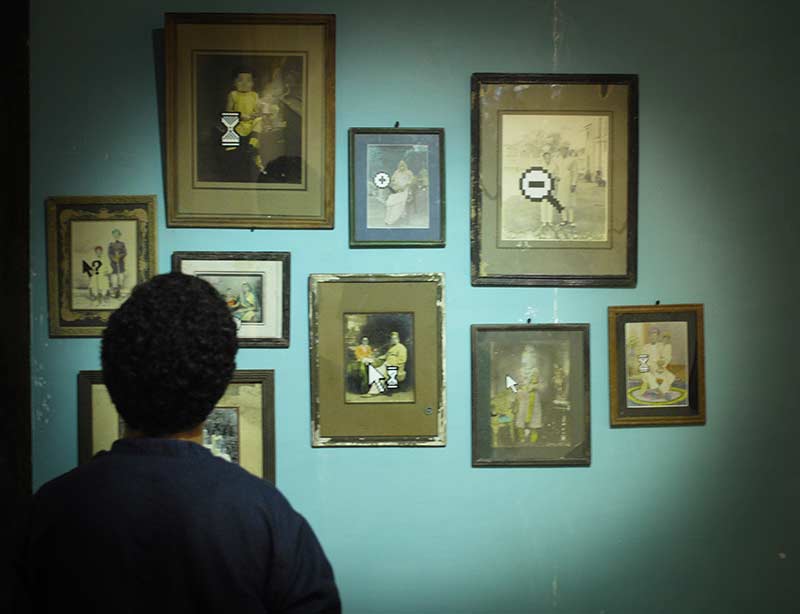
The New Touch. Acrylic on found photographs and vintage frames. 2011. Installation view from the exhibition The Census of Sense (2011). Curator – Veeranganakumari Solanki. Exhibit 320, Delhi.
What inspires you? Let’s talk about your frameworks, references and process.
Our constant interaction with the screen & all that the screen entails, is the one key inspiration. Second inspiration is the idea of a cultural identity, specifically in the Indian context. Through my work, I continuously juxtapose these to arrive at tangible ideas that exist on the threshold of tradition and modernity, reality and virtuality, past and future.
The process is simple. Every image is an original vintage photograph & is painstakingly painted upon to look like a digital image/ print. We do not use any digital reproductions at the studio. Every work of mine that you see has an actual historical image at its base. I really revere them & there is no room for error. Although over the years, I have ruined some really beautiful photographs, where my artistic intervention couldn’t do justice to the image. It is heartbreaking, but inevitable.
The references I have already touched upon in the previous question.
Let’s talk about your career, or if you prefer artistic journey. What were your biggest learning and hiccups along the way?
It all sums up in one question; “But, why is the face obscured/ pixelated/ blurred?!”
I have failed to find a convincing answer to this question that has haunted me in every viewer interaction in every exhibition ever. The irony is that after ten years of creating these works, I still don’t really know. It is something deep within my subconscious that compels me to do it and I simply make allowance for it.
It is a huge deterrent for lots of clients as well. A lot of times, I have been even told that they “wish I had pixilated another area & not the face.” The thing is that, a lot of people consider it inauspicious to keep something ‘defaced’ in the house.
What can I say? It is just what I do. It’s just how I see these images. And the biggest learning is that one has to do what one believes in, no matter what. And while it sounds like a cliché, it has taken me years to come to terms with it. And I still struggle a lot. A very famous artist even went on to rebuke me once, for speaking like this about my art.
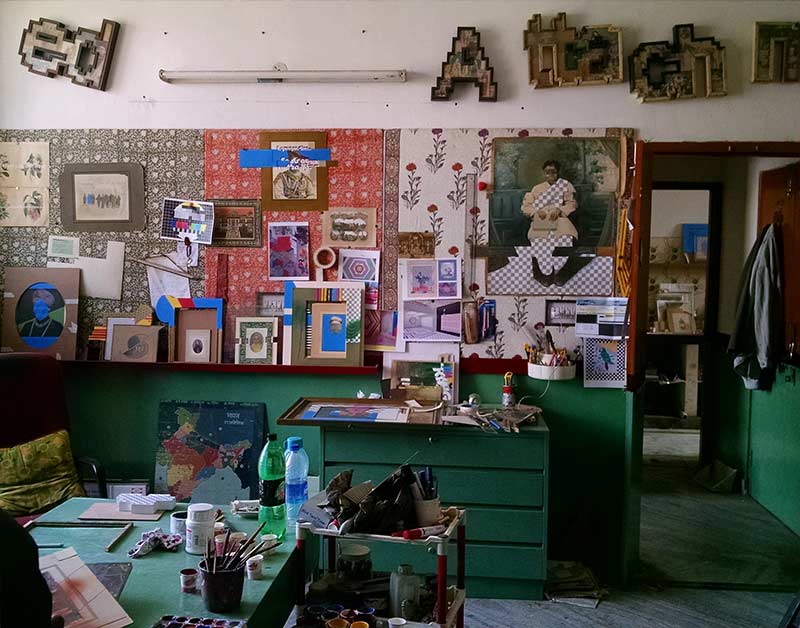
Studio Nandan Ghiya Jaipur, 2018
What are you looking for when you look at other artists’ work? Which shows, performances and experiences have shaped your own creative process? Who are your maestros?
I have had no formal education in art. I have been my own teacher and mentor. I am really inspired by the idea of art itself. To me, art must provoke. It must force me to reconsider my choices, my perceptions in life. Not to say that art cannot simply be, something beautiful to just behold and not require any articulation.
Jeanne Claude & Christo’s wrapped pink islands, Paul McCarthy’s clown videos, Barbara Krueger’s rants, Patrick Caulfield’s collage-like paintings, Gerhard Richter’s blur paintings, Tom Wesselmann’s cutouts, Rene Magritte’s meditative surrealism & Yayoi Kusama’s immersive spaces, I deeply admire. But most importantly, it is 1960’s Pop art & 1990’s YBA that have informed my practice the most. Not because I admire them so much, but simply because I was introduced to these movements as a fashion student by friends in my formative years. And I suppose those things stay with you the most.
Also, I was frequenting Shekhawati a lot in that time period with my dad to buy old textiles & photographs (late 1990’s & early 2000’s). The nameless artists who painted murals and frescoes on the havelis, depicting Indian mythology juxtaposed with colonial influences and technological development of the time-period, are my maestros.
And lastly, Quentin Tarantino’s pastiche cinema and in general, post-apocalyptic & futuristic (Sci-fi) films inspire me a lot as an artist.
How does your interaction with a curator, gallery or client evolve, from the initial interface to working-relationship?
With the gallery, it is a slow & organic process. It cannot be rushed, no matter what. Both the artist and the gallery have to understand that. That’s how it is with the two galleries I work with, in India. I avoid any interaction with the clients & prefer the gallery handling that bit entirely. Any clients that approach me, I prefer to direct them to the gallery. With the curator, so far it has been purely governed by the core idea/ themes of the specific shows. I feel that my work has a limited scope & either fits in or it won’t. So, most of the curators I have worked with have been limited to one or two shows. Many curators on international shows have impressively articulated about my work, without interacting with me!
Think of the biggest professional risk you’ve taken. What helped you take that risk?
I think I might have just answered that while discussing the learnings and hiccups. The biggest risk is finding newer, more artistic ways to obscure the images & make my viewers uncomfortable. I don’t do it for the effect, but to make people reflect. I think we are really taking images for granted today. We constantly generate, like and dislike them. Then we store them online or cloud and never really revisit them, rendering them redundant.
I am making an effort to make the idea of an image relevant again. And to do so, I deface it, splice it, distort it, obscure it. It is all a very risky business. Because a lot of times, I end up making rubbish of a piece of history. The obscurity sometimes gets too much for me as well. But then, “it is an artist’s responsibility to push all the boundaries” is what I tell myself.
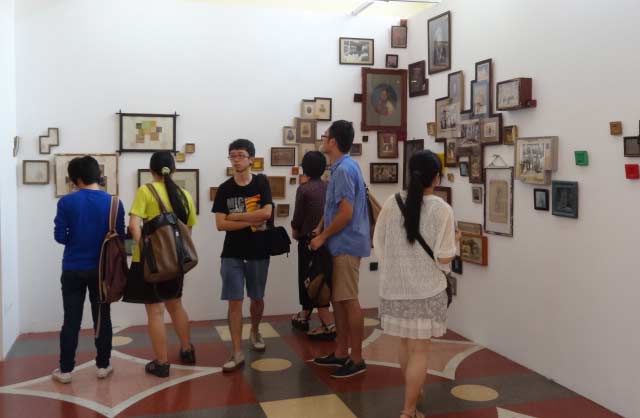
Thumbnails. Installation view from First Issue, SH Contemporary, Shanghai (2012)
What is the best piece of advice you’ve received? Any mentor, curator or gallerist who deserves a special mention for furthering your journey?
“The fact that you belong to India, must always reflect in your art. For, that is how the world will know you.” Unfortunately, I cannot recall the person who told me this.
Also there are two comments from years ago that I never forget, from two people I really revere.
Art should feed life & not feed on it, Nandan.
– Mr. Ebrahim Alkazi.
Art has to be effortless, is what Swaminathan told me.
– Aman Nath.
I have had the privilege of working with some amazing curators over the years and I really admire and respect them all equally. Mentioning one would be disrespecting another. The reason is that every curator has a distinct style, set of concerns and values that they research upon. And each show revolves around certain core idea which can never be lesser or better than another idea. It is all so subjective. All that matters to an artist to be challenged by a curator to push one’s artistic boundaries.
I must mention Rasika Kajaria of Exhibit 320, my gallerist in Delhi for the last ten years & Geetha Mehra of Sakshi Gallery, who now represents me in Mumbai. It is amazing to work with them and I wouldn’t have worked with all those amazing curators, if not for them.
Tell us about your artists studio, what kind of place is it? Could you describe your usual work-day?
The art studio is a small rented three BHK. With the exception of one room, there are floral block-printed soft-boards all over, with lots and lots of vintage photographs, prints and visual pages from old books of all sizes in various states of digitally-inspired obscurity and distortion, pinned all over them. Then there are haphazard heaps of photographs in some spaces and in others, they’re carefully stacked. One room is wooden-frame storage and workspace for a carpenter who reworks them. Till 2008, I used to make large acrylic on canvas paintings. And the last one I ever made (a 6×6’ piece), hangs on one wall to serve as a reminder of I don’t know what. There are some random pixilated 3-D form studies (sculptures) also scattered about. There’s a lot of assorted pixels and a lot of Rajasthani dust, that adds character to everything.
A usual work day would be to identify & work upon any image from the soft-boards to work further upon in terms of framing, splicing or painting. Depending on the inspiration, I might work on one or many images in a day. Sometimes you just paint a tiny pixel. Sometimes, you completely paint off a portion of a photograph with a solid colour or Photoshop grid. Sometimes, you’re cutting and sometimes you’re trying radical angles & placements to rejoin them.
Some days, there will be no work as I feel like a visitor to the studio, who will just go and ruminate on the images in display.
Are you more of a studio artist or naturally collaborative by nature? How do you feel about commissions?
I am a studio artist and my practice is collaborative by the nature, given the fact that I work with found photographs, that once were someone’s creations. What I do to an image is always governed partly by what is already there. I believe that the future is collaborative and I am always keen on that consequent interaction of values, styles and sensibilities. And commissions are a great means to that interaction.

Nandan Mahal (2017). Room view at Tijara Fort, Tijara. Photo Credits – Neemrana Hotels.
What was your first sale? Do you handle the commercials yourself or is it outsourced to a gallery/agent?
I had my first solo show in 2000 at the Hungarian Cultural Center in Delhi, while I was still studying at NIFT. An American resident designer Mr. Sandy Starkman bought my first work. It was a painted collage about Kurt Cobain’s short life.
All my commercials are handled through my two representative galleries in Delhi & Mumbai.
How does your audience interact and react to the work you put out into the world?
Like I stated earlier, it all sums up in one question;
“But, why is the face obscured/ pixelated/ blurred?!”
What are you working on now? What’s coming next season?
Last year, I had a kind of mid-career retrospective in Jaipur at the JKK in collaboration with the Alkazi Foundation and the City Palace museum, curated by Rahaab Allana. The same show, which was a showcase of ten years of my practice travelled this year to Sakshi Gallery, Mumbai.
I am just taking a break right now. 2020 is a weird threshold. What will the next ten years of my art practice be all about, is the question I am currently exploring. Also, researching traditional Indian art history, miniature painting schools and Indian mythology and doing some digital studies on femininity inspired by the same. Just indulging in a bunch of disconnected stuff to fill a quiet blank, an artistic void. With a desperate need to evolve, I am trying to take each day as it comes in these unprecedented times.
There was a group show in the planning at the NGMA, just before the lockdown. But, let’s see.
What were you working on when the lockdown was announced?
While pondering over new directions for my art practice, I decided to revisit the most rudimentary of all artistic processes- Drawing. I created some works, interpreting my son’s old scribbles into pixelated frames for a group show in Delhi. I was looking for more references to explore it further, while identifying more of his scribbles to work upon. And then, the lockdown put a break to it.
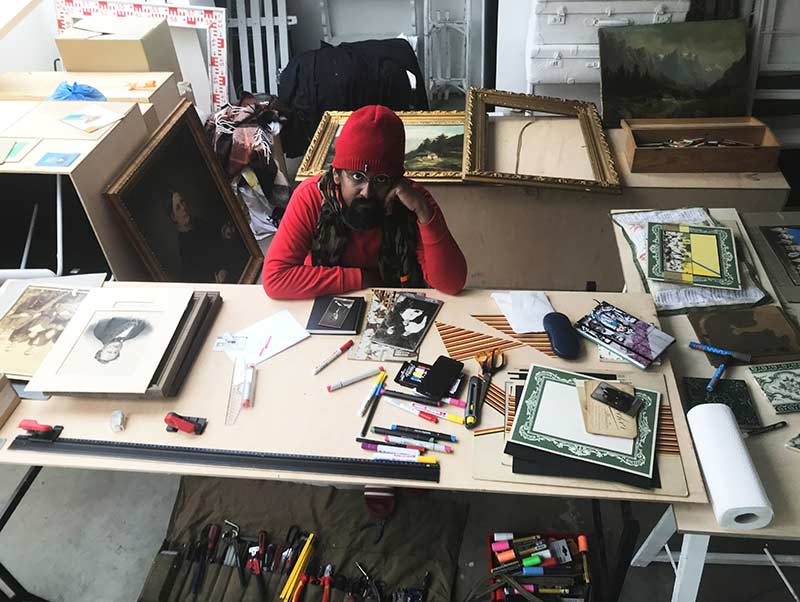
Artist in Residence (2017). India Week, Hamburg. Photo Credits: Arne Loesekann.
How has this affected your practice and plans?
It gave me an opportunity to indulge in all those values, that my practice wasn’t making an allowance for. And since I was looking for a break, the timing was somewhat serendipitous.
Ironically, it has also made me see my practice in a new light. Anonymity and shifting identities & spaces is what I have been concerning myself through my art for years and suddenly, it seems ever more relevant. There has to be a shift in our collective consciousness et al. I wonder where it will take us and I also wonder, how it will then translate and reflect in my work. I am wondering if it will reflect or will my art be countering it? I guess right now is the time to absorb and not rush into planning.
What would elevate artists’ life during this period?
I really can’t say. They are organising all kinds of virtual webinars, showcases and discussions. Screen fatigue is taking over, more than anything. We all need to take it easy right now. Every day, 15000 plus cases in India alone. It’s like a sci-fi movie. Watching post-apocalyptic movies, I used to always wonder what becomes of artists in such times. You always only see scientists, doctors, soldiers playing significant role in such narratives. It is worrisome. But then, making art is the only thing that ever elevated my life, no matter what the period.
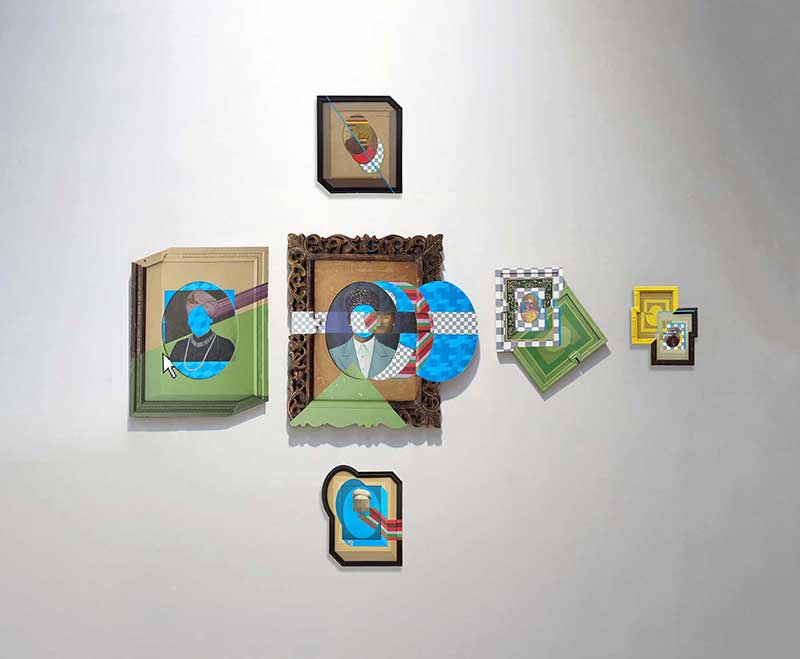
Studio Portraits from the 22nd Century. Acrylic on found photographs and vintage frames. 2011-19. Photo Credits – Sakshi Gallery, Mumbai.
What kind of critical inputs does the art world need at this moment to overcome the loss of income and opportunity as a direct result of the worldwide lock-downs?
That is a big and important question, but one I’m incapable of answering. But sometimes I feel that the art world needs to really broaden its scope and reach out to a much wider audience & identify opportunities where none existed, even before the lockdown. People need to be educated and engaged much more at levels that are far reaching, way beyond the four gallery walls or art fairs. The governments need to be pursued to put panels and policies in place, as whatever exists now is quite redundant. Artists may not say so, but they are first in the line of fire in any crises. Or think about the fact that, if every professional college graduate has placement opportunities awaiting them, why can’t artists? My father didn’t let me go to an art school. He is an art dealer & still felt, it was too risky.
We aren’t doing enough in a country with population like ours. I think every organisation of every discipline & field needs an artist on board.
How are you balancing life and work at home during this period?
The sense of day/night, weekday/weekend has been really altered. It is all too surreal- like the movies. It has suddenly become about survival- to get on from one day to the next. I cook, watch movies, read art history books, sample 1980’s music, teach online, do juries & feedbacks, make Photoshop compositions & use Refresh Tears abundantly! My bed has become a tiny island & I feel ‘cast away’.
Before you go – you might like to browse our Artist Interviews. Interviews of artists and outliers on how to be an artist. Contemporary artists on the source of their creative inspiration.












Add Comment